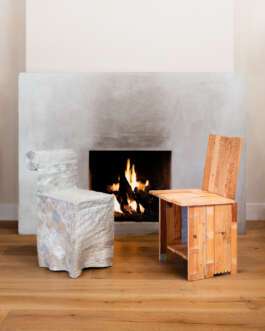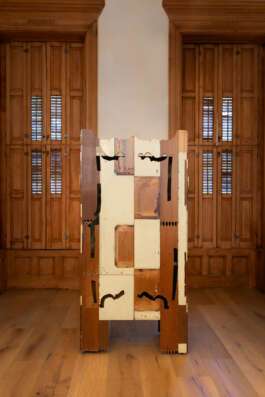



© Yuxuan Huang Studio
COLLECTIBLE In-Depth
Yuxuan Huang & Jesse Groom
August 2024
This series, COLLECTIBLE In-Depth, unveils the backstage of contemporary creation. Tackling various topics from personal designer processes to the position of collectible design on the global design market, COLLECTIBLE In-Depth offers different views to suit all tastes. Today we speak with Yuxuan Huang and Jesse Groom.
C: Why do you focus on contemporary collectible design? What does it mean for you?
YH & JG: For us, collectible design is about inquiry, curiosity, and conversation. Hailing from opposite sides of the world, Chengdu and Brooklyn, we design objects which communicate something beyond aesthetic functionality, about themselves and/or about their makers, thus converging on the platform of collectible design. Small-scale production creates an intimacy with materials, and often its manifestation (fabrication and result) is an opportunity to ask new questions about the objects we live with. To work in collectible design means being in conversation with one another and the world around us, both animate and inanimate.
C: Can you talk about a new collection that you release for COLLECTIBLE this year?
JG: Cicatrix is a series of objects amid a developing inquiry into how practicing becomes the practice itself. The mirror presented at COLLECTIBLE this year, Mirror 02, takes queues from Mirror 01, seen at Alcova Miami, and continues the research in an earnest fashion. While I sit and finesse my skills as a welder, marking the surfaces to become “other-thingly,” the objects contort then relax, becoming themselves although born from the same process as their predecessors.
YH: Lost Stories presents a collection of furniture and objects featuring a deconstructive re-imagination of antique pieces, conveying the stories of people and objects that have been lost in time. Inspired by my experience with thrifting, I aimed to give abandoned furniture a new life by returning it to a raw material state. Dirty paint, scratches, glue marks, and dust thus became my new materials, liberating the narratives and mysteries of the past for the new objects.
C: How do you question or challenge functionality in your design process?
JG: Avoid dogmatic modern tropes about how “form follows function,” I attempt to put function at the same level as form. In doing so, I reminisce about an era of making that valued and gave meaning to the objects in our lives, beyond their scalability and profitability. In my process, ornament becomes necessary as part of the final form to not just be able to function, but to communicate to the world about itself and its inception. I like to use a phrase I repeated in my discovery process: “made to be used… but not just that.”
I prefer the open-ended, and inquisitive, rather than the definitive, and authoritative.
YH: Functionality becomes a way to create narratives in my design. I view functionality as the trigger that fosters interactions between humans and objects, shaping the dynamics of space and memories. Imagining how people will use my designs and envisioning their life stories with these objects is always a source of inspiration for me. My furniture has a performative nature; people need to use it to fully uncover its meaning. Functionality can be very poetic, as it forges intimate stories between people and objects.
C: Can you discuss a specific cultural or historical reference that has inspired your recent work in collectible design?
JG: I’ve often referenced the work and writing of Japanese architect Terunobu Fujimori in the last couple of years. His approach to design, summarized by an unconventional traditionality and primordial production techniques, I believe is the answer to a future where humans and technology will cohabitate harmoniously. I see the success of his buildings as evidence for the desirability of imperfect surfaces and odd outcomes which are more honest to material and existence than perfectly manicured materials and spaces. In the face of rapidly developing technology and AI, we need to not forget the importance of making design honest and relatable, a trait which I feel Fujimori never lost sight of.
C: How do sustainability-related questions influence your practice?
YH: Sustainable materials always catch my eye more than others. Specifically, I’m very interested in recycled materials and natural sustainable materials crafted using traditional pre industrial techniques. I have a deep empathy for these materials; the imprint of the maker and users on them is a source of wonder and inspiration for me, and I aim to share this magic with those who use my work. Additionally, my work advocates for a care for both nature and humanity. Raising awareness of our close relationship with nature in modern life is crucial for sustainability, and furniture serves as an excellent medium for this education.

© Yuxuan Huang Studio

© Yuxuan Huang Studio

© Yuxuan Huang Studio
COLLECTIBLE In-Depth
Yuxuan Huang & Jesse Groom
August 2024
This series, COLLECTIBLE In-Depth, unveils the backstage of contemporary creation. Tackling various topics from personal designer processes to the position of collectible design on the global design market, COLLECTIBLE In-Depth offers different views to suit all tastes. Today we speak with Yuxuan Huang and Jesse Groom.
C: Why do you focus on contemporary collectible design? What does it mean for you?
YH & JG: For us, collectible design is about inquiry, curiosity, and conversation. Hailing from opposite sides of the world, Chengdu and Brooklyn, we design objects which communicate something beyond aesthetic functionality, about themselves and/or about their makers, thus converging on the platform of collectible design. Small-scale production creates an intimacy with materials, and often its manifestation (fabrication and result) is an opportunity to ask new questions about the objects we live with. To work in collectible design means being in conversation with one another and the world around us, both animate and inanimate.
C: Can you talk about a new collection that you release for COLLECTIBLE this year?
JG: Cicatrix is a series of objects amid a developing inquiry into how practicing becomes the practice itself. The mirror presented at COLLECTIBLE this year, Mirror 02, takes queues from Mirror 01, seen at Alcova Miami, and continues the research in an earnest fashion. While I sit and finesse my skills as a welder, marking the surfaces to become “other-thingly,” the objects contort then relax, becoming themselves although born from the same process as their predecessors.
YH: Lost Stories presents a collection of furniture and objects featuring a deconstructive re-imagination of antique pieces, conveying the stories of people and objects that have been lost in time. Inspired by my experience with thrifting, I aimed to give abandoned furniture a new life by returning it to a raw material state. Dirty paint, scratches, glue marks, and dust thus became my new materials, liberating the narratives and mysteries of the past for the new objects.
C: How do you question or challenge functionality in your design process?
JG: Avoid dogmatic modern tropes about how “form follows function,” I attempt to put function at the same level as form. In doing so, I reminisce about an era of making that valued and gave meaning to the objects in our lives, beyond their scalability and profitability. In my process, ornament becomes necessary as part of the final form to not just be able to function, but to communicate to the world about itself and its inception. I like to use a phrase I repeated in my discovery process: “made to be used… but not just that.”
I prefer the open-ended, and inquisitive, rather than the definitive, and authoritative.
YH: Functionality becomes a way to create narratives in my design. I view functionality as the trigger that fosters interactions between humans and objects, shaping the dynamics of space and memories. Imagining how people will use my designs and envisioning their life stories with these objects is always a source of inspiration for me. My furniture has a performative nature; people need to use it to fully uncover its meaning. Functionality can be very poetic, as it forges intimate stories between people and objects.
C: Can you discuss a specific cultural or historical reference that has inspired your recent work in collectible design?
JG: I’ve often referenced the work and writing of Japanese architect Terunobu Fujimori in the last couple of years. His approach to design, summarized by an unconventional traditionality and primordial production techniques, I believe is the answer to a future where humans and technology will cohabitate harmoniously. I see the success of his buildings as evidence for the desirability of imperfect surfaces and odd outcomes which are more honest to material and existence than perfectly manicured materials and spaces. In the face of rapidly developing technology and AI, we need to not forget the importance of making design honest and relatable, a trait which I feel Fujimori never lost sight of.
C: How do sustainability-related questions influence your practice?
YH: Sustainable materials always catch my eye more than others. Specifically, I’m very interested in recycled materials and natural sustainable materials crafted using traditional pre industrial techniques. I have a deep empathy for these materials; the imprint of the maker and users on them is a source of wonder and inspiration for me, and I aim to share this magic with those who use my work. Additionally, my work advocates for a care for both nature and humanity. Raising awareness of our close relationship with nature in modern life is crucial for sustainability, and furniture serves as an excellent medium for this education.

© Yuxuan Huang Studio

© Yuxuan Huang Studio
Contact
info@collectible.design
VIP PORTAL
EXHIBITOR PORTAL
PRIVACY POLICY
© 2025 Collectible
Contact
info@collectible.design
VIP PORTAL
EXHIBITOR PORTAL
PRIVACY POLICY
© 2025 Collectible